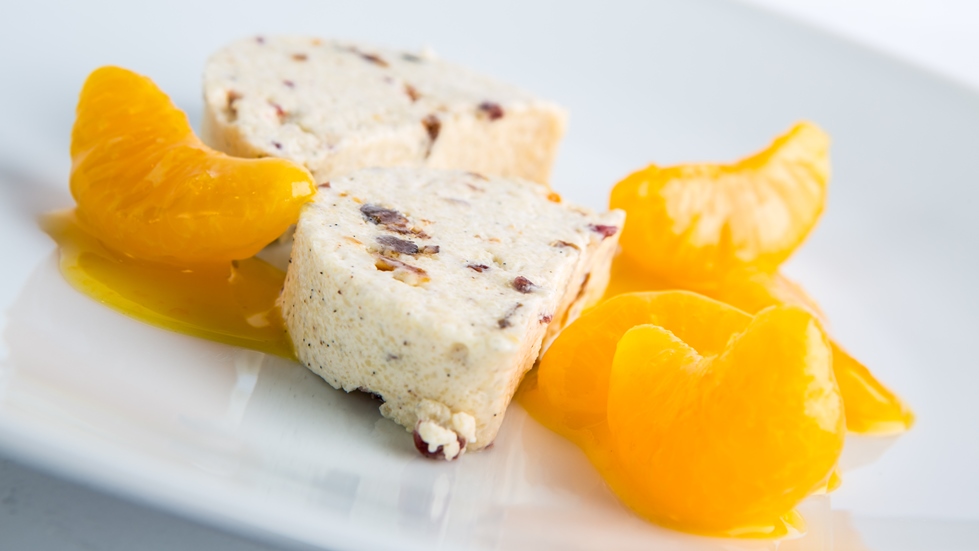This year we would like to present you with a somewhat different menu for the Christmas season. Vegetarians amongst us will be pleased as the following recipes are completely meat and fish free. And perhaps some of the meat eaters reading these posts will also enjoy the variety these meat-free alternatives provide to the usual feasting over the festive period. Furthermore, many cancer patients are interested in eating more consciously and limiting their consumption of meat. According to the WCRF (World Cancer Research Fund), consumption of sausages and meat products should be restricted to 500g per week. Processed meat products such as smoked, cured or salted meats, or products with chemical additives to prolong shelf life, should particularly be avoided. Eating fish and poultry is preferable to red meat such as beef, pork or lamb. When buying meat, we recommend paying attention to the information about how the animal has been reared and fed!
On the other hand, foods of plant origin – such as grains, vegetables, fruit and pulses – should be prioritised as most foodstuffs which have the ability to protect against cancer predominantly come from these nutritional sources. We recommend paying attention to the origin of such products as well. Scientific studies show that consumption of plant-based foods is probably connected to a lower risk of developing various forms of cancer. Consequently, five portions (one handful) of fruit and vegetables should be part of your daily menu.
Christmas menu:
Starter: Chicory with blood oranges
Main course: Cauliflower quinoa
Dessert: Spiced-semolina flummery with mandarins and dried fruit
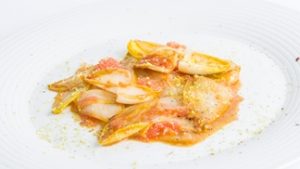 1. For the starter we recommend the chicory with blood oranges recipe which was posted in the blog on 10 February 2016 . Chicory is a common winter vegetable and is readily available at this time of year.
1. For the starter we recommend the chicory with blood oranges recipe which was posted in the blog on 10 February 2016 . Chicory is a common winter vegetable and is readily available at this time of year.
2. The cauliflower quinoa recipe forms the main course of our suggested menu. Quinoa, a modest plant and basic form of nutrient in the Andes region of South America in particular, is gaining increasing popularity in Germany. As a result of new varieties it no longer contains bitter compounds and can also be cultivated well in Europe. Quinoa has a high-quality protein content and is also gluten free.
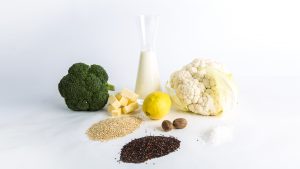 Ingredients for 4 persons:
Ingredients for 4 persons:
50 g white quinoa
50 g black quinoa
350 g cauliflower
50 g broccoli
200 ml milk
100 ml water
70 g butter
Olive oil, salt, nutmeg
lemon zest
Tips from Michelin-star chef Martin Fauster:
Instead of cauliflower you can also use romanesco in this dish.
It is best to use a vegetable mill in order to create a really fine cauliflower purée.
This dish can be kept in the fridge for c. 2 days and quantities can be easily reduced to make the recipe for fewer persons.
Preparation: (c. 60 minutes)
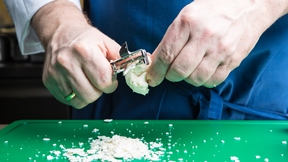 Step 1
Step 1
Using a vegetable slicer or peeler, grate approximately 90g from the cauliflower florets. Cut the broccoli into small florets with a vegetable knife. Put the cauliflower and broccoli to one side (for the vegetables in quinoa).
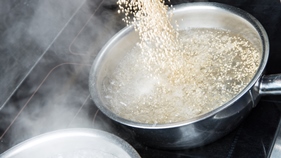 Step 2
Step 2
Cook the two types of quinoa separately in salted water until soft and then drain well. Whilst the quinoa is cooking, cook the rest of the cauliflower for the cauliflower purée in the water-milk mixture with some salt and nutmeg until tender (c. 15 mins).
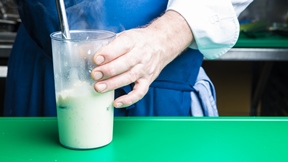 Step 3
Step 3
Drain off the tender cauliflower in a sieve, collect the water as you drain it. Purée the cauliflower in a mixer (it can be made especially fine through the use of a vegetable mill). Gradually add some of the water the cauliflower was cooked in until you achieve the desired consistency. Then season to taste with some brown butter (‘beurre noisette’ – see the “brown butter” video), salt and nutmeg. Keep the purée warm until you wish to serve the dish (keep covered on a low heat).
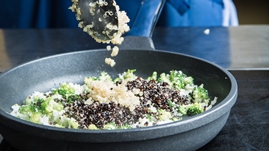 Step 4
Step 4
Sauté the small broccoli florets in some olive oil (without letting them turn brown), then add the grated cauliflower and sauté together. Next add the cooked quinoa and season to taste with salt, nutmeg and finally some lemon zest. Bon appetit!
Alternative: For those who would prefer a heartier option, we recommend Hans Haas’ recipe for Wildschönau style grey cheese (Graukäse) pastries. You can find this on the free TZM “HealthFood” cooking app.
3. The dessert for this Christmas menu is spiced-semolina flummery with mandarin ragout and dried fruit – an ideal dessert for winter.
Tips from Michelin-star chef Martin Fauster:
It is best to prepare the semolina a day in advance. You can also prepare the mandarin ragout the day before. This dessert can be kept covered in the fridge for approximately 2 days and quantities can be easily reduced to make the recipe for two persons.
A perfect garnish for this dessert is to add pomegranate seeds. Instead of using a terrine dish, you can also serve individual portions of this dessert in tumblers.
Ingredients for 4 persons:
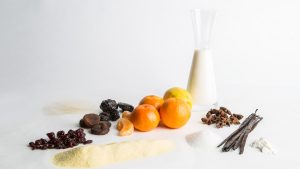 To make the semolina flummery:
To make the semolina flummery:
40 g sugar
250 g milk
1,5 g Quatre-épices seasoning
40 g spelt semolina
1 vanilla pod
1 star anise
1 pinch of salt
2 leaves of gelatine
250 g whipped cream
30 g prunes
25 g dried apricots
25 g dried cranberries
Zest of half a lemon
To make the mandarin ragout:
400 g freshly squeezed, strained mandarin juice
8 g cornflour (starch thickener)
4 St. mandarins
1 squeeze of lemon juice
Zest of half a mandarin
Preparation: (c. 60 minutes)
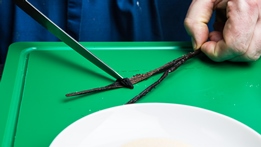 Step 1
Step 1
First soak the gelatine in cold water. Place the milk, sugar and all spices in a pan. Scrape the pulp out of the vanilla pod with a knife and add both to the pan. Bring the milk mixture to the boil.
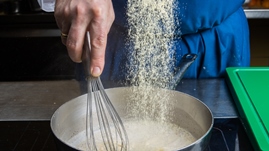 Step 2
Step 2
Use a whisk to continuously stir the semolina whilst adding it to the pan. Simmer on a moderate heat and keep stirring for c. 4 to 5 minutes until a thick semolina pudding forms.
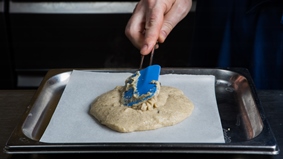 Step 3
Step 3
Now remove the semolina from the heat, squeeze the gelatine which has been soaked and mix in. Spread the mixture on a baking tray and leave to cool to room temperature.
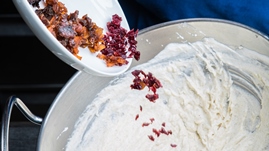 Step 4
Step 4
Remove the spices (vanilla pod and star anise) from the cool semolina mixture. Place the mixture in a bowl and briefly stir with a whisk. Then stir in the whipped cream followed by the small pieces of chopped dried fruit. Place in a terrine dish or tumblers and refrigerate (for best results prepare the day before so that the semolina is really firm).
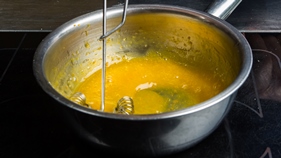 Step 5
Step 5
To make the mandarin ragout – heat the mandarin juice and reduce a little. Then add the cornflour with 3 tablespoons of water and mix into the juice (bring to a vigorous boil). Peel the mandarins and divide into the individual segments. Soak in water. Now carefully scrape off the pith using a knife.
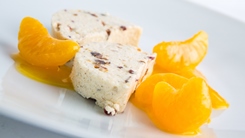 Step 6
Step 6
Place the mandarin segments into the warm sauce and place in the fridge for the next few days or serve the dessert immediately. For best results when cutting the semolina, use a sharp knife which has been immersed in lukewarm water shortly before use. Bon appetit!
All of these recipes can also be found on our “HealthFood” cooking app, which can be downloaded for free from the App Store or Google Play. In addition to the app and this vegetarian menu by star cheft Martin Fauster, TZM’s “Stark gegen Krebs” book (‘Strong against cancer’ – in German only) is now available – and would make the perfect Christmas gift.
